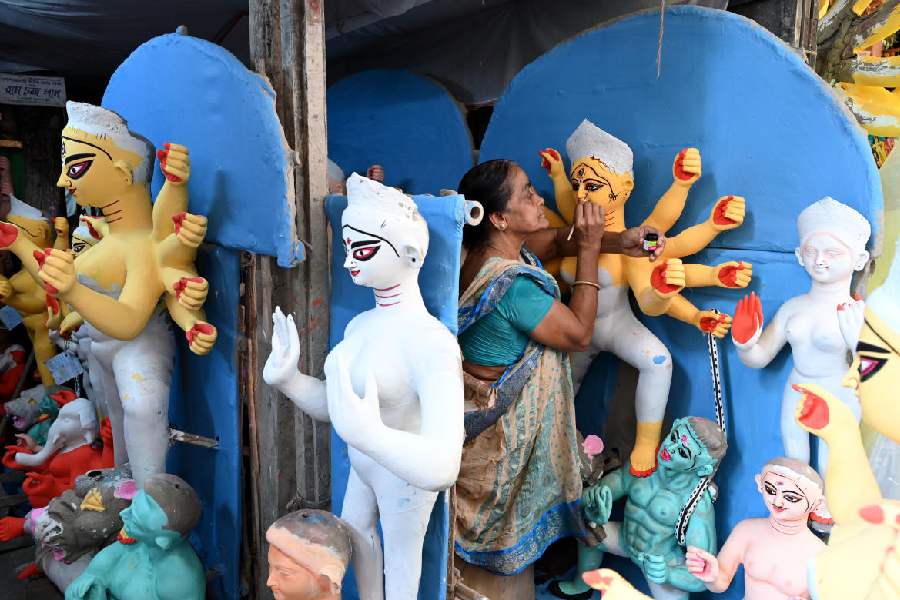The goddess — now on her way to Bengal — had slayed the demon. But some asurs seem to have survived in Kumartuli’s wet, serpentine lanes; and the women artisans who shape the goddess out of clay, and also cement, copper and plaster these days, know that their fight against these demons will be a long one.
One such woman artist, who now runs the studio of her father Hemanta Kumar Pal, remembers the days, early on in her career, when the demons lurked in the corners. “I began managing my father’s studio after his death in 1994. I remember how in those days some of the idols I made would be disfigured mysteriously. People asking for directions to the studio would also be given erroneous directions.”
That has changed — but not by much. The Telegraph’s enquiry for directions to her studio was met by the following remark by some male artisans of another workshop: “Oh oi urinal er pasher artist ke khnujchhen?… Oh, you are looking for the artist who works next to the urinal?”
But the ogres — of then and now — could not deter this lady’s artistic eye.
Learning quickly from the other, more experienced, male workers in the studio, she picked up such intricate crafts as the mixing of different kinds of clay — entel maati and bele maati — the creation of a mishmash of colours, the decoration of the goddess.
“What I enjoy the most is decorating the goddess. But I am still not good when it comes to bichali-bnadha, which involves tying the straw framework of the idols,” confessed the 50-year-old. “I make idols of Durga, Jagaddhattri, Ganesh, Saraswati and — my favourite — Kali.”
Tellingly, even after all these years of craftsmanship, she — Calcutta is now familiar with China Pal — finds it difficult to let go of some of her creations. She directs my gaze towards an exquisite ek chalar thakur: “She is on her way to Bhopal and I must finish the pending work before the deadline. But my heart won’t let her leave.”
A few lanes away, Mala Pal has no time for sentiment. Her demeanour is brisk, businesslike, she barks instructions at her male colleagues, even as she rattles off the challenges faced by women artisans like her. And the list is long.
The word “theme”, for instance, seems to transform Mala into a fiery deity herself. “The craze for themes is unfortunate. The demands made of artists to adhere to themes is irritating. It is a distortion of tradition. It must stop.”
Next in her line of fire are tightfisted Puja organisers. She rattles off a list of names, people who have, she alleges, been rather parsimonious when it comes to making payments for the idols. “My idols receive both timely payments and respect from connoisseurs — be they art aficionados or Puja organisers — abroad.”
She then turns her verbal trishul in the direction of the government to make a legitimate point. “You came walking through these lanes dripping with sludge and waste. Tell me, how does it feel? Do you think the younger generation, especially women, would like to continue working under these difficult conditions and in spaces that offer little by way of reflection, privacy and hygiene? I have been hearing talk of Kumartuli’s artisans being shifted to a new, modernised site for years now. Nothing has happened. Is this the government’s way of respecting Kumartuli’s artists?”
She pauses to catch her breath. As if on cue, the artisans surrounding her — all men — return to work briskly.
The volume of orders for Durga idols has improved since the pandemic ended. China was unwilling to provide details of her income this season but said that things were finally looking up a bit. But she complained bitterly about the escalating cost of material. “The price of plywood that cost Rs 275 earlier has shot up as has the
price of clay; ek khop maatir daam ekhon 1,300 taka… The most basic measure of clay costs Rs 1,300.”
Compounding the problem is the lack of institutional finances. This is yet another demon that afflicts all artisans, but women artists feel the pinch the most.
Kakoli Pal, who does not have her own studio to make the idols, is on record stating that she had to approach moneylenders for financial help.
Despite the litany of problems confronting Kumartuli’s women artisans, Babu Pal of the Kumartuli Mritshilpi Sanskritik Samiti hopes that women idol makers — according to one estimate, there are 20-25 of them in Kumartuli’s workforce of around three lakh employed directly or indirectly — would inspire many more to join the craft. Their creativity and dedication, Babu stated, are formidable.
He has a point.
In an adjoining lane, China’s studio has transformed itself, momentarily, into a hub of attention. Instagrammers gawk at her creations taking shape; a young woman reporter is speaking live to the camera in front of one of the idols; photographers are jostling for the correct angle for their shots.
But China is unperturbed, her eyes are fixed on the forehead of the goddess she is bringing to life, one dab of paint at a time.

